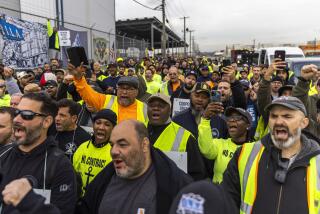S. Korea Labor Strife Cuts Flow of Exports : Massive Unrest Also Slashes Current Accounts Surplus in August
- Share via
SEOUL, South Korea — The worst labor strife in South Korea’s history drove down the flow of exports by $772 million in August, an 18.5% decline from July, the Bank of Korea disclosed Tuesday.
Overseas sales after strikes began to sweep the country in July still registered a 20.3% gain, compared to August, 1986. The $4-billion trade surplus for the first eight months remained 35.2% above the same period the year before, the bank reported.
A surplus in current accounts also plummeted to $468 million in August from $1.1 billion in July. But for the first eight months, the measure of both trade and such non-trade transactions as shipping, tourism and insurance payments amounted to $5.7 billion, a 38.4% gain, compared to the same period last year.
The announcement came as the last of the major strikes that swept nearly 60% of South Korea’s large firms came to an end at the massive Hyundai shipyard in Ulsan. Hyundai Heavy Industries Co. said 20,887 workers, or 97% of its employees, reported for work Tuesday as 4,500 riot police stood guard.
The workers marched into the plant, without incident, past about 300 picketing Hyundai laborers who demanded that the strike continue until 40 jailed workers are released.
Management credited a letter written from a jail cell by Lee Hyong Gon, a leader of a newly formed union at the nation’s largest shipyard, with ending the violent 21-day strike.
Lee appealed to workers to accept management’s offer of a 14% wage increase, retroactive to Sept. 1, and a pledge to try to secure the release of arrested workers before Oct. 7, the date of Chusok, the traditional full moon fall festival that is celebrated as a national holiday. Workers had been demanding a 17% wage increase, while management had earlier refused to go beyond an 11% raise.
Turmoil at the shipyard began in late July but calmed down after the government intervened in mid-August, ordering the management to meet most of the workers’ demands. It erupted again Sept. 1, forcing the firm to shut down the plant.
Since July 1, strikes have affected 3,400 work sites, or more than the total affected during all of the past 11 years. Turmoil erupted after Roh Tae Woo, the ruling Democratic Justice Party’s candidate to succeed President Chun Doo Hwan in an election to be held by Dec. 20, promised June 29 to end authoritarian rule and transform South Korea into a democracy.
Since then, Roh and the ruling party have proposed revisions to both the constitution and labor laws that would guarantee workers the right to bargain collectively, to stage strikes and to organize freely and establish industrywide unions.
Employers, who have been forced to grant workers wage increases averaging 18%, including normal pay raises approved earlier in the year, have said they may be forced to trim payrolls by as many as 500,000 workers to shave costs.
Nearly $2 billion worth of production has been lost in the often-violent strife that has swept 58% of the firms employing more than 1,000 workers, the government has announced. Although the turmoil now appears to be dying out, exports are expected to fall about $2.5 billion short of the government’s goal of $45 billion by the end of the year.
Even that kind of shortfall, however, would still leave the nation with $7.8 billion more in exports than last year, or a gain of 22% for the year.
The labor strife also precipitated a halt in the appreciation of the won, South Korea’s currency, which rose 6% in value against the dollar through the end of June. Since then, the won has gained only 0.4% in value, stirring new complaints from the United States. American officials have been urging South Korea to let its currency rise in value to curtail a growing trade surplus with the United States, which last year reached $7.1 billion.
A senior government official Tuesday told foreign correspondents that the Korean currency would remain at its current level of about 800 won to a dollar for the foreseeable future.
By halting appreciation of the won , South Korean government officials were reportedly hoping to compensate exporters for the increase in labor costs that they otherwise would have borne from a more valuable won . A higher won forces manufacturers either to raise prices in dollars or accept less profit in won for their exports.
The Bank of Korea said exports of machinery, toys, textiles and electronics goods continued an upward spiral in August despite labor troubles.
Only overseas shipments of automobiles, down 2.1%, and tires, which dipped 4.2%, declined in absolute amounts, compared to year earlier, the bank said.
In July, auto exports, mostly to the United States, had soared 108%, compared to the same month a year earlier.
Even tourism was unaffected by the turmoil, with earnings from foreigners’ spending here rising to $128 million, up 44% from a year earlier, the bank said.
More to Read
Sign up for Essential California
The most important California stories and recommendations in your inbox every morning.
You may occasionally receive promotional content from the Los Angeles Times.













